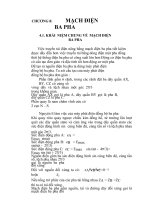Bài giảng hệ phân tán chương 8 Sửa lỗi trong hệ phân tán
Bạn đang xem bản rút gọn của tài liệu. Xem và tải ngay bản đầy đủ của tài liệu tại đây (3.33 MB, 50 trang )
Trần Hải Anh – Distributed System
CHƯƠNG 8: FAULT
TOLERANCE
TS. Trần Hải Anh
1
Content
2
1.
2.
3.
4.
5.
6.
Introduction to fault tolerance
Process resilience
Reliable client-Server Communication
Reliable Group Communication
Distributed Commit
Recovery
Trần Hải Anh – Distributed System
3
1. Introduction to fault tolerance
1.1. Basic concept
1.2. Failure models
1.3. Failure masking by redundancy
Trần Hải Anh – Distributed System
1.1. Basic concept
4
¨
Being fault tolerant related to Dependable systems which
cover:
¤ Availability
¤ Reliability
¤ Safety
¤ Maintainability
•
•
•
•
•
Fail/Fault
Fault Tolerance
Transient Faults
Intermittent Faults
Permanent Faults
Trần Hải Anh – Distributed System
1.2. Failure models
5
¨
Different types of failures
Typeoffailure
Descrip0on
Crashfailure
Aserverhalts,butisworkingcorrectlyun8lithalts
Omissionfailure
Aserverfailstorespondtoincomingrequests
Receiveomission
Aserverfallstoreceiveincomingmessages
Sendomission
Aserverfallstosendmessages
Timingfailure
Aserver'sresponseliesoutsidethespecified8meinterval
Responsefailure
Aserver'sresponseisincorrect
Valuefailure
Thevalueoftheresponseiswrong
Statetransi8onfailure Theserverdeviatesfromthecorrectflowofcontrol
Arbitraryfailure
Aservermayproducearbitraryresponsesatarbitrary8mes
Fail-stopfailure
Aserverstopsproducingoutputanditshal8ngcanbedetectedbyothersystems
Fail-silentfailure
Anotherprocessmayincorrectlyconcludethataserverhashalted
Fail-safe
Aserverproducesrandomoutputwhichisrecognizedbyotherprocessesasplainjunk
Trần Hải Anh – Distributed System
1.3. Failure masking by redundancy
6
¨
Three possible kinds for masking failure
¤ Information
redundancy
¤ Time redundancy
¤ Physical redundancy
¨
Triple Modular Redundancy (TMR)
2. Process resilience
7
2.1. Design issues
2.2. Failure masking and replication
2.3. Agreement in faulty system
2.4. Failure detection
Trần Hải Anh – Distributed System
2.1. Design issues (1/3)
8
¨
Process group
¤ Key
approach: organize several identical processes into a
group
¤ Key property: message is sent to the group itself and all
members receive it
¤ Dynamic: create, destroy, join or leave
Trần Hải Anh – Distributed System
2.1. Design issues (2/3)
9
•
Flat Groups versus Hierarchical Groups
¤ Comparison
Advantages
FlatGroups
HierarchicalGroups
Disadvantages
Symmetrical
Nosinglepointoffailure
Complicateddecisionmaking
Groups8llcon8nueswhileoneoftheprocesses
crashes
Loss of coordinator brings the
Easydecisionmaking
grouptohalt
2.1. Group membership(3/3)
10
•
Group Server
•
Distributed way
Approach
- Send request
- Maintain databases of all groups
- Maintain their memberships
Disadvantages
- A single point of failure
Approach - each member communicates directly to all others
Disadvantages
- Fail-stop semantics are not appropriate
- Leaving and joining must be synchronous with data messages being sent
•
Membership issues
What happens when multiple machines crash at the same time?
2.2. Failure masking and Replication
11
•
-
-
-
Primary-based protocols
Used in form of primary-backup protocol
Organize group of processes in hierarchy
Backups execute election algorithm to choose a new
primary
•
-
Replicated-write protocols
Used in form of active replication or quorum-based
protocols
Organize a collection of identical processes into a flat
group
Called ‘k fault tolerant’ if system can survive faults in k
components.
-
-
2.3. Agreement in Faulty systems (1/3)
12
•
1.
2.
3.
4.
•
Different cases
Synchronous versus asynchronous system
Communication delay is bounded or not
Message delivery is ordered or not
Message transmission is done through unicasting or
multicasting
Circumstances under which distributed agreement can be
reached
Trần Hải Anh – Distributed System
2.3. Agreement in Faulty systems (2/3)
13
•
Byzantine agreement
Assuming N processes, each process i provides a value vi
Goal: construct a vector V of length N
If i is nonfaulty then V[i] = vi
•
Example: N = 4 and k = 1
2.3. Agreement in Faulty systems (3/3)
14
Lamport et al. (1982) proved that agreement can be achieved if
- 2k+1 correctly process for total of 3k + 1, with k faulty
processes
(or more than 2/3 correctly process with 2k+1 nonfaulty processes)
•
•
Fisher et al. (1985) proved that where messages is not delivered
within a known and finite time -> No possible agreement if even
only one process is faulty because arbitrarily slow processes are
indistinguishable from crashed ones
Trần Hải Anh – Distributed System
2.4. Failure Detection
15
•
•
Two mechanisms - Active process and Passive Process
Timeout mechanism is used to check whether a process has
failed. Main disadvantages:
-
-
•
How to design a failure detection subsystem?
-
-
-
•
Possible wrong detection when simply stating failure due to unreliable
networks. Thus, generate false positives and a perfectly healthy process
could be removed from the membership list
Failure detection is plain crude, based only on the lack of a reply to a
single message
Through gossiping
Through probe
Regular information exchange with neighbors -> a member for which the
availability information is old, will presumably have failed
Failure detection subsystem ability?
-
-
Distinguish network failures from node failures by letting nodes decide
whether one of its neighbors has crashed
Inform nonfaulty processes
the failure
detection using FUSE
Trần Hảiabout
Anh – Distributed
System
approach
16
3. Reliable Client-Server
Communication
3.1. Point-to-Point Communication
3.2. RPC Semantics in the Presence of Failures
Trần Hải Anh – Distributed System
3.1. Point-to-Point Communication
17
•
Point-to-point communication is established by using reliable
transport protocols
- TCP masks omission failures by using acknowledgments and
retransmissions -> failure is hidden from TCP client
Crash failures cannot be masked because TCP connection is
broken
-> client is informed through exception raised
-> Let the distributed system automatically set up a
new connection
-
Trần Hải Anh – Distributed System
3.2. RPC Semantics in the Presence of
Failures (1/5)
18
•
•
RPC (Remote Procedure Calls) hides communication by
remote procedure calls
Failures occur when:
- Client is unable to locate the server
- Request message from the client to the server is lost
- Server crashes after receiving a request
- Reply message from the server to the client is lost
- Client crashes after sending a request
Trần Hải Anh – Distributed System
3.2. RPC Semantics in the Presence of
Failures (2/5)
19
•
•
Client is unable to locate the server, e.g. the client cannot locate a
suitable server, or all servers are down…
-> Solution: raise Exception
Drawbacks:
- not every language has exceptions or signals.
- Exception destroys the transparency
Lost request Messages, detected by setting a timer
- Timer expires before a reply or ack -> resend message
- True loss -> no difference between retransmission and original
- So many messages lost -> client gives up and concludes that the
server is down, which is back to “Cannot locate server”
- No message lost: let the server to detect and deal with
retransmission
Trần Hải Anh – Distributed System
3.2. RPC Semantics in the Presence of
Failures (3/5)
20
•
Server Crashes
(a) Normal Case
(b) Crash after execution
(c) Crash before execution
Difficult to distinguish between (b) and (c)
-
(b) the system has to report failure back to the client
-
(c) need to retransmit the request
3 philosophies for servers:
¤ At least once semantics
¤ At most once semantics
¤ Exactly once semantics
4 strategies for the client
-
Client decide to never reissue a request
-
Client decide to always reissue a request
-
Client decide to reissue a request only when no acknowledgment received
-
Client decide to reissue a request only when receiving acknowledgment
3.2. RPC Semantics in the Presence of
Failures (4/5)
21
•
Server Crashes (next)
8 considerable combinations but none is satisfactory
- 3 events: M (send message), P (print text), C (crash)
- 6 orderings
combinations
1.
2.
3.
4.
5.
6.
All possible
M -> P -> C
M -> C (-> P)
P -> M -> C
P -> C –(> M)
C (-> P -> M)
C (-> M -> P)
Conclusion
- The possibility of server crashes changes the nature of RPC and distinguishes
single-processor systems from
distributed systems
Trần Hải Anh – Distributed System
- In former case, a server crash also implies a client crash
3.2. RPC Semantics in the Presence of
Failures (5/5)
22
•
Lost Reply Messages
Solution: rely on a timer set by client’s operating system
Difficulty -> The client is not really sure why there was no answer: lost or slow?
-
Idempotent request: asking for the first 1024 bytes of a file has no side effects
and executing as often as necessary without any harm
-
Assign sequence number: server keeps track of the most recently received
sequence number from each client and refuse to carry out any request a second
time
-
•
Client crashes
Solution: activate computation called “orphan”
Difficulty:
- Waste CPU cycles
- Lock files or tie up valuable resources
- Confusion if the client reboots and does RPC again
- Alternative solutions:
- Orphan extermination
- Reincarnation
- Gentle Reincarnation
- Expiration
-
Trần Hải Anh – Distributed System
23
4. Reliable Group Communication
4.1. Basic Reliable – Multicasting Schemes
4.2. Scalability in Reliable Multicasting
4.3. Atomic Multicast
Trần Hải Anh – Distributed System
4.1. Basic Reliable – Multicasting
Schemes
24
•
•
•
Multicasting means that a message sent to a process group,
should be delivered to each member of that group
In presence of faulty process: multicasting is reliable when all
nonfaulty group members receive the message
Solution to reliable multicasting when all receivers are known
and assumed not to fail
Message
Transmission
(a)
(b) Reporting
feedback
Trần Hải Anh – Distributed System
4.2. Scalability in Reliable Multicasting
(1/2)
25
•
•
Problem of reliable multicast scheme it that cannot support
large numbers of receivers
Nonhierarchical feedback control
- Key: reduce the number of feedback messages returned
- Model: feedback suppression which underlies the scalable
reliable multicasting (SRM)
- In SRM, receiver reports when missing message and multicasts
its feedback to the rest of the group. Other group members will
suppress its own feedback.









